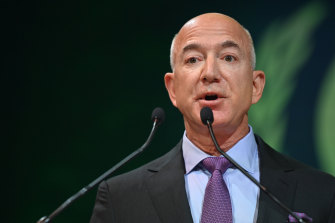“Rising cost pressures and uncertain outlooks from the largest technology names have investors agitated going into the weekend and investors are not likely to be comfortable any time soon with the Fed widely expected to deliver a 50-basis point hike along with a hawkish message next week,” said Charlie Ripley, senior investment strategist for Allianz Investment Management.
The S&P 500 fell 155.57 points to 4,131.93 Friday. The benchmark index is now down 13.3 per cent for the year. The Dow dropped 939.18 points to 32,977.21. The Nasdaq slid 536.89 points to 12,334.64. It’s down 21.2 per cent so far this year.

More than $US10 billion has been wiped from the fortune of Amazon founder Jeff Bezos as shares in the tech giant tumbled more than 14 per cent overnight.Credit:Getty
Smaller company stocks also had a rough day. The Russell 2000 slid 53.84 points, or 2.8 per cent, to 1,864.10.
Big Tech has been leading the market lower all month as traders shun the high-flying sector. Tech had posted gigantic gains during the pandemic and now is starting to look overpriced, particularly with interest rates set to rise sharply as the Fed steps up its fight against inflation.
Internet retail giant Amazon slumped 14 per cent, one of the biggest decliners in the S&P 500, a day after reporting a rare quarterly loss and giving investors a disappointing revenue forecast. The weak update from Amazon comes as Wall Street worries about a potential slowdown in consumer spending along with rising inflation.
Prices for everything from food to gas have been rising as the economy recovers from the pandemic and there has been a big disconnect between higher demand and lagging supplies. Russia’s invasion of Ukraine has only added to inflation worries as it drives price increases for oil, natural gas, wheat and corn.
The Commerce Department on Friday reported that an inflation gauge closely tracked by the Federal Reserve surged 6.6 per cent in March compared with a year ago, the highest 12-month jump in four decades and further evidence that spiking prices are pressuring household budgets and the health of the economy.
The latest report on rising US inflation follows a report from statistics agency Eurostat that shows inflation hit a record high in April of 7.5 per cent for the 19 countries that use the euro.
Loading
Bond yields rose following the hot readings on inflation. The yield on the 10-year Treasury rose to 2.92 per cent from 2.85 per cent.
Persistently rising inflation has prompted central banks to raise interest rates in order to temper the impact on businesses and consumers.
Much of the anxiety on Wall Street in April has centred around how quickly the Fed will raise its benchmark interest rate and whether an aggressive series of hikes will crimp economic growth. The chair of the Fed has indicated the central bank may raise short-term interest rates by double the usual amount at upcoming meetings, starting next week. It has already raised its key overnight rate once, the first such increase since 2018, and Wall Street is expecting several big increases over the coming months.
Investors spent much of April shifting money away from Big Tech companies, whose stock values benefit from low interest rates, to areas considered less risky. The S&P 500’s consumer staples sector, which includes many household and personal goods makers, was the only sector in the benchmark index to make gains in April. Other safe-play sectors, such as utilities, held up better than the broader market, while technology and communications stocks are among the biggest losers.








